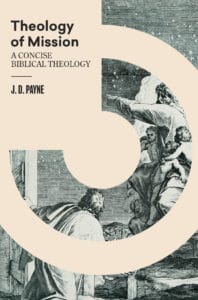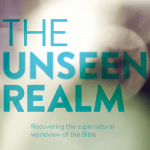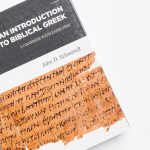
In this excerpt from Theology of Mission: A Concise Biblical Theology, J. D. Payne introduces a missional hermenutic to interpret the overarching story of mission in the Bible.
Whenever I ask a class for biblical support of God’s mission in the world, the Matthean account of the Great Commission (Matt 28:18–20) is usually the first passage referenced. Of course, there is nothing wrong with pointing to this Scripture. Whenever I ask for another passage, Acts 1:8 is often stated, then a general reference to Paul’s missionary journeys. Beyond these, I usually receive no additional support.
Why is this the case? Is this all there is in the Bible when it comes to God’s mission—just a few texts? God has chosen to reveal himself through many books, and is his mission only connected to a few sentences in two books? Is this all the Bible provides on the topic? Have we allowed a few verses to be the primary support system for the church’s modern apostolic work? While Matthew 28:18–20 is a rich text and incredibly important to the church’s task, there is so much more in the Bible related to God’s mission. In fact, the global mission task would still be valid even if Jesus never spoke those words.
Throughout the twentieth century, mission came to mean a variety of activities. Little has changed today. The church frequently engages in actions labeled “missions,” even if the gospel of Jesus Christ is never shared! We continue to reside in a world of competing voices, some better than others. This is true within the church and outside the church. We need to know what is contained in the Scriptures, especially when it comes to such an important topic as our study. Theology shapes Christian decision-making.
Missional Hermenutic
The Bible is comprised of multiple stories that unite to form one grand story revealing God and his mission. As with all forms of biblical interpretation, a missional hermenutic method does not escape limitations. However, since God is a God of mission and brings glory to himself, this theme should be prevalent throughout the Scriptures and worthy of consideration.
The entirety of Scripture’s story is about mission. This hermeneutic should be granted significant priority because it derives from the unity of the entire canon of Scripture. This approach to interpretation allows the reader to see the beginning, end, and the way between these two points of the biblical storyline. One way to consider this approach to the Scriptures is like a “map,” that does not provide “every tiny feature of a landscape,” but offers a way to see the entire biblical terrain and how to navigate through it. Comprised of and built from smaller stories, the Bible contains a metanarrative of the Creator who creates a good creation that is corrupted by the fall, and who labors to redeem and recreate that which presently groans under the weight of sin.
The Bible was birthed in the context of God carrying out his purpose in the world to redeem a people for himself and restore a groaning creation.
Pattern of purpose throughout Scripture
The glory of God among his image-bearers comes through sending and relationship. It is in and through relationship that the nations are blessed with the expectation they will enjoy such benefits and leverage them for God’s glory among others. There is a particular pattern that repeats itself throughout the Scriptures in relation to God’s mission: sending to the world → proclaiming hope through judgment → entering relationship → receiving blessing. God takes the initiative and comes to his creation, or sends his representative(s). A message of hope is shared but reveals that his good news involves judgment and consequences for sin. Those who embrace God’s message by faith enter into relationship with him and his kingdom people and experience his blessings.
From Genesis to Revelation, God’s purpose and work in the world reveals a God who receives glory through relationship and blessing. At creation, he blesses man and woman (Gen 1:28); his promise to Abraham involves blessing (Gen 12:1–3); life in the kingdom involves blessing (Matt 5:1–11); and Revelation concludes with blessing to those able to enter the new Jerusalem (Rev 22:14). While relationship with God brings such favor, his benefits (Psalm 103:2) were not given simply for selfish consumption. Though to be enjoyed, the blessings were to be used appropriately to glorify himself. The psalmist was quick to note the relationship between receiving the blessings of God and God’s glory among the nations (Psalm 67). It was Israel’s failure to follow such desire that resulted in the selfish transformation of her blessings into the idols that resulted in Assyrian and Babylonian captivity.
Prior to the fall, God comes to Adam and Eve, enters into relationship, and blesses them. As his image-bearers, they were to populate the planet with other image-bearers (Gen 1:28). God’s mission meant he would be glorified by his vice-regents throughout the world. The planet would serve as a temple where people would have intimate fellowship with the Creator without knowing the mediatorial function of a priest. Rather, mankind would be a holy priesthood unto God.
After the fall sin brings judgment, but God’s grace brings hope. God stills takes the initiative to come to his creatures, but does so with a message of blessing through judgment (Gen 3:14–15, 21). Relationship will be restored and blessing will come, but atonement must be made for sin. The earth was still to be filled with God’s image-bearers (Gen 6:1; 9:1), but the effects of sin would spread throughout the population living on a groaning planet (Rom 8:19–23). Again, a pattern emerges from the Scriptures related to God’s purpose in the world: sending → hope through judgment → relationship → blessing.
God takes the initiative to come to his elect, but he does so with a message of hope through judgment. The sin that separates himself from mankind must be addressed. Relationship with God involves a judgment on sin and a faith that brings fellowship. Covenants are cut with the death of animals all foreshadowing the new covenant to come. Mankind and God now enter into relationship through judgment because of sin. But even with judgment, blessings are given and to be enjoyed and used for God’s glory. Relationship results in new community with God and his people.
God comes to Moses and sends him to Egypt to deliver Israel from slavery. The message, to both Israel and pharaoh, was that hope would come to God’s people, but judgment would come first. Such would befall Egypt, but Israel would have to judge her own sin and be sanctified according to God’s plan. The final plague that brought deliverance was only avoided through obedience to God’s instructions. At Sinai, God entered into a covenant with his people. They were to be “a kingdom of priests and a holy nation” (Exod 19:6). The covenantal relationship would bring great blessings but also great responsibilities. Israel was to be a light to the nations, pointing God’s image-bearers to their Creator who alone was worthy of glory.
Shortly after David becomes king of Israel, God comes to him following this pattern of purpose. The message of hope through judgment is communicated in that David will eventually die, but God will raise up his offspring as part of an eternal kingdom (2 Sam 7:13). Through this Davidic covenant, blessings will come to be enjoyed and used for God’s glory.
The long-awaited Davidic descendant would arrive in the fullness of time (Gal 4:4). He was sent to the people of Israel (John 1:14) with a message of hope through judgment. The new covenant in his blood would reveal the full extent of God’s judgment on sin and grace and blessing on the nations. As the Father had sent the Son into the world to carry out his purpose, prior to the ascension, the Son would send his disciples to repeat the pattern until he returned.
As the church is sent into the world to encounter image-bearers separated from God, a message of hope through judgment is communicated. People must die to self in repentance toward God and faith in his Messiah (Acts 20:21). Such action brings them into a new kingdom community in which both present and future blessings are a reality (Acts 3:19–20). The pattern of purpose repeats itself as those newly blessed in turn begin to steward well their blessings as they are sent into the world with the message of hope through judgment.
This post is adapted from Theology of Mission: A Concise Biblical Theology by J. D. Payne (Lexham Press, 2022).







